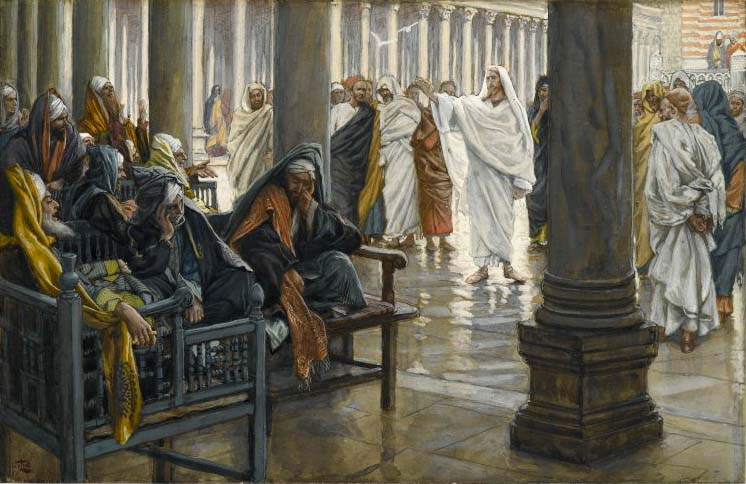Honor and Shame in Gehenna
Honor and Shame
When current Bible scholars attempt to interpret a biblical text, the most common methodology they employ is what many call the “historical-critical” method (though some conservative scholars, such as William Klein and Craig Blomberg refer to it as the “historical-cultural” method, possibly because the word “critical” often times has negative connotations to a conservative evangelical). This methodology seeks to understand the text from an entirely historical perspective. For example, many Christians will make assertions such as “The Bible is true!” or “The Bible is historically accurate,” or even “Everything in the Bible literally happened in that manner.” These assertions depend on both historical reliability and historical plausibility for the interpreter to determine what the text means based on known historical accuracies.
However, our understanding of history is incomplete, leaving the interpreter attempting to rationalize and justify the biblical narratives as being “accurate” using whatever historical data we currently possess. Of course, since our knowledge of history is deficient, this can pose a problem to the contemporary expositor who seeks to reconstruct the text from an exclusively historical perspective, which can often lead to conjecture or, at best, educated guesses. Nevertheless, even realizing the incompleteness of historical data, the historical-critical method (HC) remains the most dominant form of exegesis among modern Christians (especially western Christians) who think they can “prove” the Bible “true” constructed on historical facts.
Missing Context
Since many contemporary Christians consider the Bible to be literally true in every story contained within it and are generally preoccupied with demonstrating that the Bible is a historical narrative worthy of being included among modern historical textbooks, they often times end up missing the underlying message of what is trying to be conveyed with the words in the pages. Since the standard conservative evangelical will attempt to assert that the Bible is inerrant, infallible, and trustworthy in every single story, they may fail to realize that the message beneath the story is what is significant to a first-century (or earlier) Jewish community.
It should be noted, however, that the HC does not only look at historical events and interpret the Bible strictly from those particular events. The HC method, while appealing to those same historical events, likewise considers the history of Israel and its religions, other ANE religious history, archaeology, as well as textual data from surviving manuscripts. Where it is lacking, however, is in the sociology, ethnology, psychology, and anthropology method of interpretation that has become much more prevalent in recent years due to the ability of interpreters to understand the biblical text in a much more appropriate and culturally relevant manner.
Alternative Methodologies
These additional methodologies can be beneficial while interpreting a biblical text besides simply using the HC method. One of these alternative methods is called the “sociological methodology.” This method seeks to understand the biblical text from a sociological perspective, which interprets the Bible according to how humanity interacts with each other based on their own societal traditions, languages, and culturally specific customs and patterns. That method is beneficial because the Bible was not written as a modern history textbook but was written to convey a specific message to a specific people group for a specific reason. Therefore, to understand properly what the biblical authors had in mind, the text is best observed from a sociological point of view to see how an author attempted to convey a particular message using the common language, metaphors, idioms, and stories of the time rather than simply trying to prove every event in the Bible is “true.”
For example, if a parent were to say to a friend, “My son is really starting to remind me of Pinocchio,” do they necessarily believe Pinocchio to be a real person? Of course not. They are referencing a character in a story to help demonstrate a point. Many Bible stories function very similarly to these types of stories, such as Adam and Eve, the flood, and Jonah and the whale, to name a few. Much like how Jesus states of his death, burial, and resurrection, “for just as Jonah was three days and three nights in the belly of the sea monster, so will the Son of Man be three days and three nights in the heart of the earth” (Matt. 12:40). Many interpret this to mean that Jesus is referencing (and thus believing) that the story of Jonah is real and factually accurate from a contemporary viewpoint. However, Jesus simply references a character in a very well-known and culturally appropriate tale. No literal person needs to literally be in the belly of a monster for three days to make this announcement from Jesus a proper means for attempting to defend the reality of the story of Jonah and the whale.

Sitz im Leben
As a result, cultural traditions become essential to understand what the text reveals because each book of the Bible was written in a specific time and place. Thus, comprehension of societal rules (written or unwritten), social interactions, cultural tales, and stories, as well as the overall sitz im leben (life-setting), dictates how we modern expositors can view and interpret the text. If we support our understanding based solely on historical facts and data, we will be pathetically deficient in textual comprehension. It is vital, therefore, to use an appropriate methodology when approaching a text, especially the didactic teaching/instructional passages of the NT, so we can attempt to appreciate what the original author is attempting to express.
Accordingly, if we use the sociological-methodology, and apply that method to the gehenna sayings of Jesus, a different picture emerges centered around how society interacted and spoke with each other, along with how rabbi’s taught and instructed others concerning gehenna, rather than the contemporary, traditional, and simple “hell” meaning attached to that particular word. Additionally, the social context of how any specific culture interacted with each other is much more accessible and established among scholars than attempting to rely on simple historical facts to guide the interpreter’s conclusion about, for example, what gehenna is.
Advantages of the Sociological Methodology
This methodology is likewise beneficial for scholars because they are acutely aware of anachronisms (an act of attributing a custom, event, or object to a period to which it does not belong) or ethnocentrism (the attitude that one’s own group, ethnicity, or nationality is superior to others). Though not fool-proof, this method seeks to detach the interpreter from their own preconceived concepts by reducing (as best as possible) cultural and theological biases. As a result, this methodology directs scholars to examine the meaning of the text based on communication considerations and cultural mores of the original author’s moment in time rather than on the interpreters’ modern moment in time.
Though the expression “honor and shame” may conjure up some notions of what is honorable or shameful for a contemporary reader, understanding how the ancient civilizations perceived what is honorable and shameful to them will aid the expositor in all manners of interpretation concerning dialogues, instructional material, and teachings contained within the Bible strictly from an ancient society’s cultural context. That is fundamentally how scholars prevent anachronistic readings of the text.
Status of Honor and Shame for Judaism
Nearly all societies in the first century have some semblance of what “honor and shame” meant to them in their own time. However, the Hellenized Jewish culture appears to put a lot more emphasis on honor and shame than many other ANE cultures. That is not to say other cultures did not observe honor and shame, indeed, they did; it is just that the Jewish culture may have placed a bit more emphasis on what was honorable and what was shameful than neighboring civilizations. As such, reading the Bible, and in particular the Gospels, with a background knowledge in honor and shame methodology will help the interpreter grasp the significance of the text much more dramatically than an HC method would allow.

There are a few Bible scholars who are experts in sociological methodologies and who use this method in their writing to unravel the text so that the meaning becomes much more apparent after considering what an honor and shame perspective demands. Some of these scholars include David DeSilva, Bruce Malina, Richard Rohrbaugh, and Jerome Neyrey (I will have a good list at the bottom of this post of great NT books that deal with interpretation from this methodology). Neyrey is perhaps the one scholar who first got me to look at NT texts differently than what I was used to at the time.
Honor and Shame in Matthew
Though much of the NT, and the Gospels specifically, have much to say concerning honor and shame, the Gospel of Matthew is perhaps the most “honor and shame applicable” book in all the NT. So much so that it appears practically impossible to interpret Matthew without at least a working knowledge and general background into what honor and shame entail for an ancient society. Neyrey, in his book The Social World of Luke-Acts, states plainly, “The fact that many Americans read Luke-Acts and claim to understand what the author means is interesting, to say the least,” (Neyrey, Luke-Acts, p. 67). Though this comment is attributed to the Gospel of Luke, it is even more applicable to the Gospel of Matthew, which Neyrey also wrote about extensively in his book Honor and Shame in the Gospel of Matthew. These Gospels must be located in their proper context and sitz im leben to ascertain precisely what the author intended to convey.
This sociological methodology of Matthew is crucial to the “hell debate” because 7 of the 12 gehenna sayings are contained in Matthew’s Gospel alone, compared to 3 in Mark (though all three reside in one section of 6 verses), 1 in Luke, and 1 in James. In order to properly understand what Matthew intended when he placed the gehenna sayings on Jesus’s lips, the honor and shame component of the sociological methodology approach appears to be the most relevant method. This is partly because all the gehenna sayings are spoken by Jesus (except one in James) and directed towards the disciples or the Pharisees—never the general population. Therefore, assessing Jesus’s interaction between these two groups with an honor and shame approach illuminates what Matthew is attempting to convey rather than Jesus simply intimidating and threatening people with the concept of “hell.”
What is Honor and Shame?
Honor, as defined by Jerome Neyrey, is “the generalized term which refers to the worth or value of persons both in their own eyes and in the eyes of their village or neighborhood.” Essentially, honor describes not only how an individual thinks of themselves but, more importantly, what does society think of that individual? Do they see him as an honorable man? Does he have an honorable job? Is he educated? These are some of the things (along with many others) that society considers when assessing someone’s honor in the first century. However, there are other means to assessing one’s “honor-value.” Neyrey describes two distinct ways a person can be considered honorable in the first century, and those are called ascribed or achieved honor.
Ascribed Honor
Ascribed honor is the honor one receives without any effort put forth. Essentially, ascribed honor derives from being part of nobility. Is that person descended from a King? Are they Levite and, therefore, a priest? Are they the offspring of a government official? Were they adopted into a noble family? Matthew portrays Jesus in his genealogy as having ascribed honor by specifically listing him as a descendant from the noble line of David, from which the Messiah would eventually originate. Similarly, the miraculous birth is also a sign of ascribed honor because many literary techniques in ancient Greco-Roman writings also viewed a miraculous birth as being a sign of either divinity or kingship.
Achieved Honor
On the other hand, the synoptics (but especially Matthew) likewise portray Jesus in an achieved honor manner. Much of this is lost on contemporary Christians because the achieved honor status in the Bible is primarily comprised of the various dialogues between Jesus and the Pharisees. For example, in the first century, a method to obtain honor for oneself (or shame another) was called challenge and riposte debates (also known as “honor competition contests”). Riposte is a term deriving from the sport of fencing that means something akin to “a quick return thrust.” But socially, it means a “clever and quick reply to an insult.” These debates are in a question-and-answer format between two individuals in the middle of some of the most populated areas in the public sphere designed to spark debate with the “winner” being the one who appropriately and impeccably answers a difficult question, riddle, or even an insult so that all who are present could witness the knowledge and honor of the individual who wins the debate.

An excellent example of this is Matthew 22. In fact, the entire chapter demonstrates what a challenge and riposte debate entails. It begins with the parable of the Marriage Feast and then has the story of the Pharisees asking Jesus if it is lawful to pay tributes to Caesar. After Jesus’s response, Matthew writes, “And hearing this, they were amazed, and leaving him, they went away.” That insinuates that Jesus won the debate and the Pharisees left with no response to Jesus, thus gaining honor in the public eye.
The Pharisaic Challenges
The remainder of this chapter is much the same. At the end of every response from Jesus to the Pharisees or Sadducees’ questions, the narrator writes about them leaving Jesus and retreating without an answer. That is an essential part of the narration because the retreat would be considered shameful for the reason that the supposed “smartest and most honorable” individuals could not respond and, therefore, lost the debate. The most forceful illustration of the Pharisaic defeat comes at the end of Ch. 22 when the author states, “No one was able to answer Him a word, nor did anyone dare from that day on to ask Him another question.” Jesus won honor from the ones previously regarded as “most honorable,” thereby solidifying his own honor at the expense of those challenging him.
A final illustration of a challenge and riposte debate that incorporates Jesus winning his honor at the expense of the Pharisees is from Luke 13:10-17. This is the story of Jesus healing a woman who was sick for 18 years, caused by an evil spirit to the point of being hunched over and unable to stand up straight. Luke writes that Jesus healed her in front of everyone in the synagogue, including the synagogue’s official. Notice the public speech recorded by the author when he declares, “But the synagogue official, indignant because Jesus has healed on the Sabbath, began saying to the crowd in response.” Again, here is a direct and public challenge to Jesus’s honor, designed to prove Jesus was wrong and, therefore, guilty of breaking the Torah because he healed on the Sabbath.

Jesus answered this accusation of being a lawbreaker by saying, “You hypocrites, does each of you on the Sabbath not untie his ox or donkey from the stall and lead it away to water it? And this woman, a daughter of Abraham as she is, whom Satan has bound for eighteen long years, should she not have been released from this restraint on the Sabbath day?” The subsequent sentence by the author of Luke sums up precisely the desired outcome from the winner of the challenge and riposte debates when he writes, “And as He said this, all His opponents were being humiliated; and the entire crowd was rejoicing over all the glorious things being done by Him.”
Shame
Though these are only a few examples, there are many others in the Gospels, such as this, with someone challenging Jesus’s honor, and Jesus not only “winning” the debate but humiliating his opponents at the same time, bringing honor to himself but shame to the challengers.
Conversely, shame is defined by scholar and professor Jerome Neyrey as “the loss of respect by some in public and has an unyielding negative connotation.” Shame is what everyone desires to avoid because of how society perceives that individual. If one is shamed, it is difficult, if not impossible, to regain their honor. Especially if one were in a prominent, publicly honorable role (such as the Pharisees), being shamed and humiliated by a poor carpenter from Galilee would signify a shame in the public eye that is completely devastating and embarrassing for the challenger.
Conclusion
The Gospels all portray this honor and shame culture in many various ways. Matthew’s Gospel is replete with honor and shame language, so much so that it may be virtually impossible to interpret what Matthew is attempting to reveal if one does not have at least a background understanding of what honor and shame truly entails. This entire post is designed to reorient the interpreter to see honor and shame values throughout the stories of Jesus and, therefore, be able to place the gehenna passages in its proper cultural context more prominently. In the ensuing posts, I will demonstrate how honor and shame plays such an important role to the gehenna passages through a series of culturally relevant ideas that shape how the biblical text should be understood.
Good sources on honor and shame:
Jerome Neyrey, Honor and Shame in the Gospel of Matthew
Jerome Neyrey, The Social World of Luke-Acts
David DeSilva, Honor, Patronage, Kinship & Purity: Unlocking New Testament Culture
Craig Keener, The Gospel of Matthew: A Socio-Rhetorical Commentary.
Robert H. Stein, The Method and Message of Jesus’ Teachings
Gerd Theissen. Sociology of Early Palestinian Christianity
Good overview of Honor and Shame in a chart format HERE
Previous Post: Child Sacrifice in Gehenna
Next Post: Honor and Shame in Jewish Burial Practices


